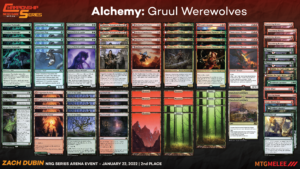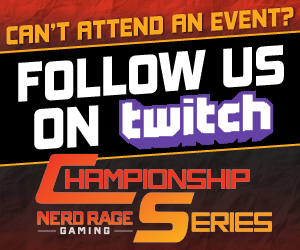Tearing into Alchemy with Gruul Werewolves
When I started playing magic back in 2016, Shadows Over Innistrad was the latest set, and I fell in love with werewolves. I loved the flavor of transforming at night, and the violent depictions of rage unleashed in the art spoke to my desire to turn creatures sideways. Today, I have a fully foiled werewolf-only commander deck that I cherish, so when it came to choosing a deck for the NRG Alchemy PTQ, I already made my choice.
I reached out to my friend Chris Botelho to get his thoughts on the format coming into the weekend, and he suggested Gruul Werewolves or Blue-Red Control. I had tried playing Esper Key to the Archive strategies in my previous forays into the alchemy format. However, I knew I did not want to play a bunch of blue Lier, Divide by Zero, and Key to the Archive mirrors all day; that sounded exhausting just thinking about it. So, Friday morning before the tournament, I sat down, loaded up the RG list Chris sent me and hopped into the Bronze 1 ranked queue in the arena. Ten hours and 28 matches later, I had a record of 26-2.
I locked the deck in and went to bed.
Most of the actual tournament is a blur. Still, I ran the tables in the Swiss, hitting excellent control matchups in the first four rounds, before running into Gruul Werewolf mirrors and Orzhov Midrange strategies every other round. Undefeated in the swiss, I was on the play throughout the top 8, eventually falling to the mirror in the finals.
So why play werewolves? It’s the premier aggressive strategy in the Alchemy format. Its position is even better after the first wave of Alchemy card modifications dodged the archetype almost entirely, as the change to Town Razer Tyrant was negligible. At the same time, the removal of the ability to flashback spells with Lier on opponents’ turns makes navigating combat on your turn normal again, without having to take into account all the reactionary spells in graveyards that were previously problematic for a gruul pilot. I love aggressive decks, but I also enjoy drawing cards quite a lot, which this deck’s aggressively slanted creatures do pretty well. This deck’s most ideal opening hand start involves a turn 2 Werewolf Pack Leader into Reckless Stormseeker, giving itself additional power and haste to immediately trigger the Pack Leader’s pack tactics ability, drawing a card. If you are so lucky as to have a draw in which you can follow that start up with a hasty Town Razer Tyrant on turn 4, I would be remiss to say you have a good chance at running your opponent into the ground before they can enact a game plan that can disrupt multiple threats. Tovolar, Dire Overlord’s ability to keep the cards flowing through hitting your opponents. Rahilda’s ability to steal cards off your opponent’s deck combined with power and toughness boosting abilities from Halana and Alena, Reckless Stormseeker, and Ranger Class can put your opponents into the dilemma of chump blocking or letting you draw cards over and over again.
Sideboarding with this deck is relatively straightforward and follows traditional sideboarding heuristics. Removal spells come in against creature decks, expensive and non-impactful spells come out against control decks.
The Red-X Dragons matchup is often two ships passing in the night, and the main point of interaction is removing the most crucial card in their deck, Fearsome Whelp.
Suppose you are unable to answer an early Whelp. In that case, removal should be saved to remove blockers to force through damage, as the spiraling nature of the card means the damage has been done, and killing their actual threats is where you should focus your remaining removal. The swap from Tangletrap to Plummet, as suggested by Chris Botelho, also helps in the Clerics matchup, where an x/6 Righteous Valkyrie can be Plummeted but not Tangle Trapped.
With regards to the various Clerics matchups, whether they be Esper or Orzhov, you are going to have to grind through their life gain to get them dead. Ascendant Packleader does not cut it against Lunarch Veteran, making a clean four in four out swap for Thundering Rebuke.
Kessig Naturalist is not at its best in this matchup, and the fourth copy of Tovolar has diminishing returns, especially when cutting one and two drops. This makes room for the 3 Plummets that are actual Doom Blades in this matchup. Flame-Blessed Bolt can tag an early creature on the play but is often too slow on the draw, especially given there are only 13 untapped red sources in the deck. While effectively helping grind through a board stall, Ranger Class is not a card you want to draw multiple of, so you can trim down to two copies. Brittle Blast’s exile clause can come up sometimes, especially when a Lunarch veteran is in play and is removed entirely from the game at a later point, which can be swapped with Volatile Arsonist. While the addition of Wrenn and Seven to the deck’s sideboard may seem appealing, siding in a five mana noncreature spell when your opponent is bringing in Duress post board is too slow. Clerics is one of the more volatile matchups, as their snowball starts are much more dangerous than any perfect curve that gruul can put out.
A field full of control decks is what this deck preys on, which is what I did. Your main deck is streamlined for these matchups. You are dodging their removal suites, leaning on Vanishing Verse, playing multicolored threats such as Tovolar, Kessig Naturalist, Halana and Alena, and post-board Arlinn.
In the control matchup, not much changes post-board. For decks with Key to the Archive, Outland Liberator is the card you most want to draw in every game. Because these blue control decks lean heavily on Fading Hope to buy time while setting up their gameplans, Tenacious Pup becomes a liability. Its strength lies in casting a creature, and losing that bonus when the creature is bounced can be too risky, so I prefer to trim them for the Arlinn, the Pack’s Hopes. Arlin is extremely powerful, and leveraging it during different parts of the game can make it extremely hard for an opponent to interact with. During the day, upticking and playing creatures at instant speed with a stat boost makes tapping out much more challenging and allows you to change over to night if needed. Immediate board presence from her -3 can restabilize and rebuild after a sweeper. At night, A hasty 5/5 indestructible trampling threat beats down hard. In situations where you are chaining creatures off the top of your library with an active Ranger Class or making a large Lair of the Hydra activation, the additional RG mana lets Arlin sit on the sidelines while flipping back to daytime. I played a Snakeskin Veil in the sideboard during the open decklist PTQ. However, I do not believe this is necessary when playing a closed decklist on the ladder, as your opponent will be thinking about it in games 2 and 3, gaining minor equity points, even if you don’t have it. Mtg Arena will always give you priority with a single green source available if you have a Lair of the Hydra in play, even if you cannot activate it, which bluffs the Snakeskin Veil at the same time. Having the Veil in the sideboard for open decklist events is essential. The Volatile Arsonist and or Halana and Alena number 3 can be cut to make room for it against control.
For the mirror and Mono Green strategies, you want to be as efficient as possible when jamming 4/4 creatures into each other. That means cutting all the creatures that do not directly provide card advantage and replacing them with removal spells. All four Thundering Rebukes, Brittle Blasts, and Burning Hands are the cards you most want to see in your opening hands. Don’t mulligan post-board games with two or more removal spells in hand. Ascendent Pack Leader and Kessig Naturalist just don’t cut it vs. the larger creatures that mono green can present and make for a clean swap. The new addition to the deck, Wrenn and Seven, shores up the late game, creating an increasingly significant threat that cannot be answered by red removal spells and must be dealt with through combat.
The fourth copy of Tovolar, Dire Overlord, can make for awkward draws, and the third copy of ranger class also has diminishing returns when creature sizing scales up. I suggest winning game one in the mirror, as being on the play if there is a game three can often decide who wins a mirror.
Against Rakdos Midrange, you can follow the same guidelines, minus the Wrenn and Sevens. However, the litany of discard that is packed in their deck, including Citystalker Connoisseur, makes playing five drops prohibitive in the matchup.
As with all tier 1 decks, the alchemy metagame will shift to combat the strength of the premier aggressive deck, and the ever-changing nature of alchemy as a format can also contribute to that. Until then, I highly recommend you sleeve up this deck and start gruul smashing.
https://www.mtggoldfish.com/deck/4574570#paper




